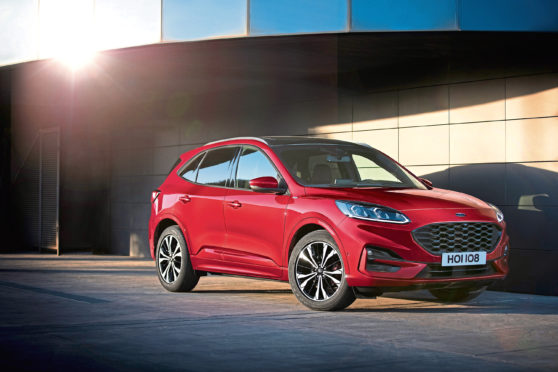Ford has taken the covers off the new Kuga.
Taking a number of design cues from the current Fiesta and Focus, the third-generation Kuga is the first Ford with a full range of hybrid powertrains, alongside three standard combustion engines.
Offered from launch, the PHEV powertrain comes with a 10.3 kWh lithium-ion battery connected to an electric motor and generator that can provide more than 31 miles (50km) of pure-electric driving – as well as claimed fuel economy of 235mpg and CO2 emissions of 29g/km. The powertrain’s overall output is 222bhp.
Ford says the PHEV comes with regenerative braking and fully charging the battery from a 230-volt supply will take four hours.
Drivers also get to choose from four driving modes.
The mild-hybrid Kuga offering – labelled EcoBlue Hybrid – features a belt-driven generator and starter motor to improve efficiency of the 2.0-litre, 147bhp EcoBlue diesel engine, with Ford claiming fuel consumption of 56.5mpg and emissions of 132g/km.
Arriving in 2020, the Kuga Hybrid comes with the same 2.5-litre Atkinson-cycle petrol engine as the PHEV as well as a Ford-developed power-split automatic transmission – with front and all-wheel-drive formats on offer. The Hybrid will deliver a claimed 50.4mpg and 130g/km of CO2.
The conventional oil-burning line-up comprises two EcoBlue diesel engines – in 1.5 and 2.0-litre guises – and a 1.5-litre EcoBoost in two states of tune.
Built on Ford’s new global C2 platform – which offers 10% extra stiffness, is 90kg lighter than the previous comparable chassis and allows for more interior space – the Kuga is sleeker than before and comes with the grille first seen on the most recent Fiesta.
With this car 44mm wider and 89mm longer than the outgoing version, interior space is much improved, while the boot has grown by 67 litres – with remote seat folding for the rear bench fitted.
Ford has not yet revealed when the new Kuga will go on sale, nor has it confirmed pricing. The current Kuga starts from £23,075.










